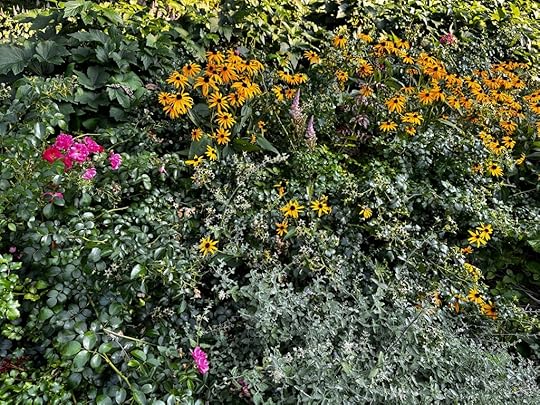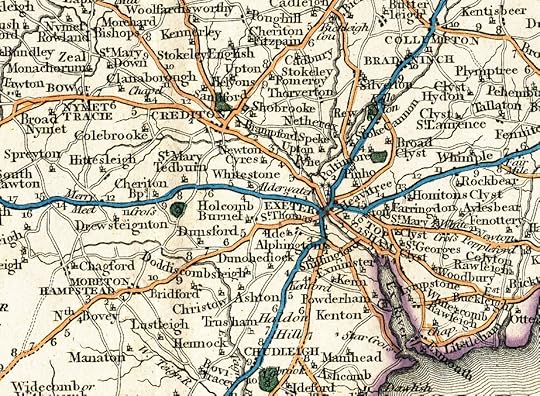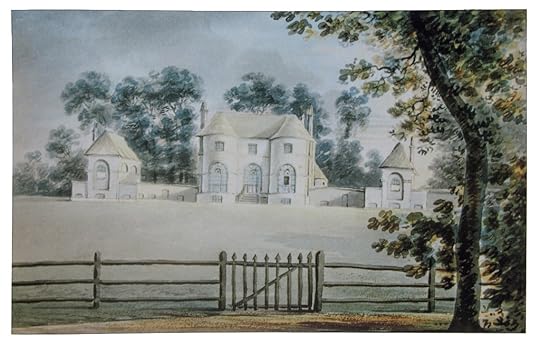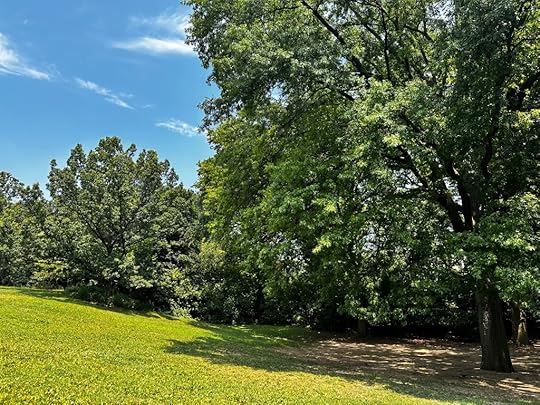Landscapes of the Mind and Map in Sense and Sensibility, by Hazel Jones
For three years in the 1970s I lived within four miles northward of Exeter in a village on a hill overlooking the River Exe. At that time, literature degree courses focused exclusively on text, and I did not think while studying Sense and Sensibility to investigate the geographical connection between this location and the Dashwoods’ Barton, still less to map the novel’s physical and mental landscapes. That contextual interest came later, together with a wider understanding of Austen’s life and writing.

(From Sarah: This is the ninth guest post in “A Summer Party for Sense and Sensibility,” which began on June 20th and will continue through to the end of the summer. You can find all the contributions to the blog series here . I hope you’ll join the conversations about S&S in the comments here and on social media: #senseandsensibilitysummer. Thanks for celebrating Jane Austen’s first published novel with us!)

Enlarged section of Devonshire map from Cary’s New and Correct English Atlas, 1821.
The area of Devon in which Sense and Sensibility is set is and was off the main tourist trail to the seaside resorts and as such was only familiar to the local inhabitants—farmers, labourers, clergy families and landowners. A few visitors, including William Gilpin, came in search of scenery worthy of being translated into art, and left disappointed, while the Revd. John Swete, who owned property south of Exeter and applied less stringent rules to his interpretation of picturesque principles, found more to inspire his pen and paintbrush. Of the countryside to the north and west of Exeter he noted that blend of beauty and utility admired by Edward Ferrars: “it would not be very easy to point out a track of Country, in admiration of whose prospect, the Landschape Painter and the Farmer would sooner coincide” (Gray, 1999, 127) he wrote in the summer of 1797.
As is usual in Jane Austen’s novels, with the exception of Persuasion, detailed descriptions of landscape are neatly sidestepped. Of Devonshire, the reader learns that there are hills and valleys, open downs and cultivated fields, woods and pastures, fine views and dirty roads, aspects of landscape common to many counties of England. Yet the location of Barton “within four miles northward of Exeter” (Volume 1, Chapter 5) is more specific than the fictional locations in the other five novels, and the physical landscape used to greater effect in revealing mental landscapes, foreshadowing concealments and eventually facilitating openness and healing.
By the time she came to revise the manuscript of Elinor and Marianne at Chawton, she had, in the early 1800s, visited Teignmouth, Dawlish and probably Sidmouth, but the sea makes no significant appearance in Sense and Sensibility, although Dawlish is mentioned and the Dashwoods’ household possessions are transported from Sussex by sea, along the south coast of England, then up the River Exe and the new canal to the busy quay at Exeter. Sir John Middleton’s summer parties on the water happen inland, presumably on rivers and private lakes, and not even Marianne voices a longing for craggy coastal scenery. Maybe Jane Austen considered Marianne’s passion for Willoughby dangerous enough without making her wild for the sea as well. Robert Ferrars alone appears to consider the coast as a destination, and then only Dawlish. Although a fashionable destination, with smart lodging houses and a strand along which to promenade, the library there was, in Jane Austen’s opinion, “particularly pitiful & wretched” (Le Faye, 279), which made it the ideal place for these two shallow characters to exhibit themselves.
Robert Ferrars’ comments on cottages in the final version of the novel might owe something to Jane Austen’s own visit to Dawlish in 1802. It is hard to imagine his lengthy pronouncement on the luxuries of cottage drawing rooms, dining rooms, libraries and spaces for eighteen couple to dance, reproduced in a letter from one sister to the other and I suspect it was added in a later revision, when Jane Austen might have seen, on the road between Exeter and Dawlish, Mr. Lardner’s cottage. The Revd. John Swete, travelling the same road in 1796, considered this ostentatious rural retreat sufficiently picturesque to be reproduced in his travel journal.

“Cottage of Lardner Esq.” by John Swete.
Mr. Lardner’s so-called cottage would not have found a place in William Gilpin’s collection of picturesque watercolours. Using thatch as a roofing material “makes it no more a cottage, than ruffles would make a clown a gentleman,” he pronounces (Gilpin, 1798, 309). Cottages familiar to Jane Austen, John Swete, and indeed the Dashwoods in their walks through the Devon landscape, were more likely to be irregular in construction, roughly thatched and clothed in vegetation, their interiors confined, dark and damp. The building material in this part of England was predominantly cob, a mixture of clay, stones, straw, animal hair and dung. The regular appearance of Barton Cottage, together with its tiled roof, suggests that it is a brick house. With its four bedrooms, two garrets, offices and two sitting rooms it sounds as comfortable as, if somewhat smaller than, the cottage at Chawton, where, soon after the move from Southampton in 1809, Jane Austen prepared Sense and Sensibility for publication.
The reworking of the novel might have begun as early as 1801, the year Richard Buller invited the Austens to stay at his rectory at Colyton on their removal from Steventon Rectory before taking up residence in Bath. A radical adjustment in Jane Austen’s own mental landscape at this time must have proved as painful as the Dashwoods’ on the loss of a much loved home. It is to be hoped that she found some consolation in the gentle hills and valleys surrounding Buller’s rectory. Her father’s former pupil also held a perpetual curacy a few miles further west at Stoke Canon—John Swete thought the village and church of picturesque merit, describing them as “pleasing objects in the centre of the most verdant pastures” (Gray, 1999, 39)—and it is possible that Richard Buller took the Austens to Exeter and from there into the landscape “four miles northward” of the city.

Attempting to pin down exact locations has always been a compelling exercise for some readers, a number of whom have taken their research into the realms of wishful thinking, but Barton place names do proliferate in this particular region: eighteen in all. Authentic-sounding place names, together with an unerring sense of what constitutes a home, are critical elements in Austen’s fiction. In Sense and Sensibility Marianne persuades herself that the loss of Norland will break her heart, but Willoughby’s arrival at Barton is enough to reconcile her to a very different emotional and physical landscape and her previous home is all but forgotten. Both sisters shed tears on leaving Sussex, but little more is said of Elinor’s feelings of loss, beyond a regret that, unlike Marianne, she had “no companion that could make amends for what she had left behind” (Volume 1, Chapter 11). The melancholy leave-taking is counteracted almost immediately at the beginning of Chapter 6 by the Dashwood women’s first view of Barton Valley—“it gave them cheerfulness. It was a pleasant fertile spot, well wooded, and rich in pasture” (Volume 1, Chapter 6).
This is the view from the window of their carriage and other views from windows form their early impressions of the immediate landscape:
The situation of the house was good. High hills rose immediately behind, and at no great distance on each side; some of which were open downs, the others cultivated and woody. The village of Barton was chiefly on one of these hills, and formed a pleasant view from the cottage windows. The prospect in front was more extensive; it commanded the whole of the valley, and reached into the country beyond. The hills which surrounded the cottage terminated the valley in that direction; under another name, and in another course, it branched out again between two of the steepest of them. (Volume 1, Chapter 6)
Fold upon fold of the landscape is perceived through a glass clearly, while layer upon layer of secrecy and deception come to be seen through a glass darkly as the narrative unravels. What constitutes a fine or extensive prospect in terms of landscape throws into focus the significance of prospect for other characters. For John and Fanny Dashwood, Mrs. Ferrars and Lucy Steele its scope encompasses the interconnected issues of marriage, money and materiality. For Elinor and Marianne, struggling against this mercenary view of human relationships, the Barton landscape seems to promise extensive prospects, but it opens up only to close down and obscure. Among the Barton hills, and later in London, Elinor and Marianne are in effect denied an unobstructed perspective of Edward’s and Willoughby’s true motivations, a shutting out that will affect their future prospects. Neither close to, nor at a distance, can either man’s intentions be discerned. When the sisters shut themselves off from each other, their limited disclosures and concealments add an extra layer of complexity.
Beyond the windows of Barton Cottage, our first glimpse of the sisters actually in the landscape comes in Chapter 9. Marianne and Margaret venture outdoors despite the threat of bad weather and encounter Willoughby in the most dramatic of circumstances, emerging from the rain and wind to scoop Marianne into his arms. Emma Thompson makes the most of the scene in her film of 1995 by adding a thick mist. The most Jane Austen offers, on his leaving Barton Cottage is: “he then departed, to make himself still more interesting, in the midst of an heavy rain” (Volume 1, Chapter 9) but it is enough to put us a little on our guard. While Marianne questions Sir John on Willoughby’s “talents and genius,” sensible Elinor asks for more direct information: ‘“But who is he? . . . Where does he come from?”‘ (Volume 1, Chapter 9).
Apart from this first encounter and the carriage drive to Allenham, which happens off the page, scenes involving Willoughby and Marianne are always set indoors, where Willoughby’s influence leads to increasingly grave social improprieties, culminating in Marianne’s very public humiliation in London. On the day of the Whitwell picnic, rather than driving about the countryside, he heads straight for Allenham Court. This is the property he is to inherit on his cousin’s death, a house familiar to the Dashwoods only from the outside. Marianne is persuaded to penetrate this forbidden territory, thus violating Mrs. Smith’s privacy and violating too her own nature, in allowing her thoughts to take a materialistic turn, as she assesses Allenham in terms of real estate.
We never learn Willoughby’s “sentiments on picturesque beauty” (Volume 1, Chapter 10) —the countryside in Devonshire provides little more than a glorified killing ground for him—remember that he carries a gun and is accompanied by two gun dogs when we first see him. Does he prefer both to hunt and elude women in more confined spaces? The enclosed urban environment of Bath provides the location for Eliza’s seduction; London is where he tracks down a rich heiress and conceals himself from Marianne among the Bond Street shops.
One or two references to William Gilpin’s writings are relevant to an understanding of Edward Ferrars’ response to his first view of Barton valley. The description of Edward’s arrival is Gilpinesque in itself, featuring foreground, distance, prospect and animation:
Beyond the entrance of the valley, where the country, though still rich, was less wild and more open, a long stretch of the road . . . lay before them; . . . they stopped to look around them, and examine a prospect which formed the distance of their view from the cottage. . . .
Amongst the objects in the scene, they soon discovered an animated one; it was a man on horseback riding towards them. (Volume 1, Chapter 16)
Although Gilpin did not appreciate many aspects of the Devon landscape—“Its very appearance on a map, shews, in some degree, its unpicturesque form” (Gilpin, 1798, 244) he asserted—and although the golden colour of ripe cornfields disgusted him on picturesque principles, he saw, as Edward did, value in the fertile soil. He wrote of the countryside around Exeter, Colyton and Honiton, which is an extension of the landscape four miles northward of Exeter:
As the mist cleared away, and we saw more of the country around, its picturesque charms did not increase upon us. If the hills and dales, however, of which the whole country is composed, possess little of this kind of beauty, they possess what is better, the riches of soil, and cultivation in a high degree. If any valleys can be said to laugh and sing, these certainly may. Nothing can exceed either their tillage or their pasturage. (Gilpin, 1798, 272)
If Edward Ferrars’ initial assessment of Barton valley—“these bottoms must be dirty in winter” (Volume 1, Chapter 16)—is hardly of the laughing, singing variety, the reader later comprehends his negative state of mind. The influence of his engagement to Lucy Steele causes him to look down at the mud, not up at the hills. His subsequent remarks are more considered:
I call it a very fine country—the hills are steep, the woods seem full of fine timber, and the valleys look comfortable and snug—with rich meadows and several neat farmhouses scattered here and there. It exactly answers my idea of a fine country because it unites beauty with utility. (Volume 1, Chapter 18)
Far from assuming the exploitative attitude to the natural world held by the three landowning Johns—Dashwood, Middleton and Willoughby—Edward is here revealing the true landscape of his mind—his yearning for a quiet, useful, rural existence within a community of “tidy, happy villagers” (Volume 1, Chapter 18). Unlike John Dashwood, arch blighter of prospects, natural, communal and familial, Edward values a “fine prospect” (Volume 1, Chapter 18) that encompasses the promise of plenty for all who live within it.
William Gilpin’s view is not a hundred miles away from Edward’s appreciation and on this occasion it is, ironically, Marianne’s passion for “rocks and promontories, grey moss and brushwood” that is misplaced. The locations to yield such picturesque stage props are the isolated stretches of Dartmoor and places on the road along which Edward travels between Plymouth to Exeter.

“West end of Okehampton Park and Dartmoor” 1800, by John Swete.
The fertile hills and valleys of the Exe can supply no grandeur to equal these, but given Marianne’s self-delusional tendencies and love of drama, it is not surprising that she interprets the surrounding landscape in this wishful-thinking way:
. . . here is Barton valley. Look up it, and be tranquil if you can. Look at those hills! Did you ever see their equals? . . . And there, beneath that farthest hill, which rises with such grandeur, is our cottage. (Volume 1, Chapter 16)
It is wish fulfilment too that hastens Marianne’s steps towards the man on horseback on the long stretch of road, believing him to be Willoughby returning from London. Elinor, conversely, does not immediately recognise Edward because she lacks any certainty in his affection and cannot allow herself to hope. The external scene might be described as “more open”; the internal state of the characters is anything but. Off his horse, Edward demonstrates a singular lack of animation, a lowness of spirits caused by his regrettable connection with Lucy Steele, which, when the true state of affairs is eventually “decided and open”—to borrow a phrase from Emma—casts a different light on Edward’s first reaction to the Dashwoods’ proposed removal from Norland:
[Mrs. Dashwood] had great satisfaction in replying that she was going into Devonshire. —Edward turned hastily towards her . . . and in a voice of surprise and concern . . . repeated, “Devonshire! Are you, indeed, going there? So far from hence! And to what part of it?” (Volume 1, Chapter 5)
The process of illuminating the real nature of Edward’s situation happens, appropriately enough, in the open, as Lucy and Elinor walk the half mile from the Park to the Cottage. Lucy’s revelations close down Elinor’s romantic prospects as the first volume comes to an end. For the following fourteen chapters of the second volume, set primarily in London, Elinor is distanced from Marianne by the weight of this disclosure, while Marianne’s concealments have already begun, following Willoughby’s departure from Barton. The nature of the landscape stands as a metaphor for secrecy and division; the deep lanes, hills and valleys where Marianne can hide to indulge and feed her grief:
If her sisters intended to walk on the downs, she directly stole away towards the lanes; if they talked of the valley, she was as speedy in climbing the hills, and could never be found when the others set off. (Volume 1, Chapter 16)
Solitary walks in the wild areas of the grounds at Cleveland, the Palmers’ house in Somerset, “where the trees were the oldest, and the grass was the longest and wettest” (Volume 3, Chapter 6) bring on the fever that almost kills her, but recovery is gradually effected among the Devon hills. At first, on her return to Barton, the familiarity of every tree and field sparks painful recollections, but eventually the landscape becomes a place of healing where greater openness in the sisters’ relationship is nurtured. The landscape of Marianne’s mind is sufficiently altered that she is able to view more or less calmly “the important hill” behind the house where she fell and first saw Willoughby. She envisages long walks into the local landscape over the coming summer and is encouraged by Elinor to talk about past expectations and sorrows while having little faith in improved prospects for herself.
Intelligence of the new Mrs. Ferrars’ departure from the New London Inn in Exeter obliterates Elinor’s last shred of hope: “She now found, that in spite of herself, she had always admitted a hope, while Edward remained single, that something would occur to prevent his marrying Lucy” (Volume 3, Chapter 12). What Edward had felt “being within four miles of Barton” she cannot bear to determine, choosing instead to close her eyes and mind both to his prospects and her own: “she knew not what she saw, nor what she wished to see;—happy or unhappy,—nothing pleased her; she turned away her head from every sketch of him” (Volume 3, Chapter 12).
When Edward arrives in person at Barton, he comes to do away with uncertainties and establish his unquestionable identity as Elinor’s lover. The landscape serves its final purpose in providing the necessary bracing air and dry lanes for Edward to “walk himself into the proper resolution” (Volume 3, Chapter 13) to ask Elinor to marry him.
Both sisters ultimately find their happiness in the neighbouring county of Dorset, where “rather better pasturage” (Volume 3, Chapter 13) for Elinor’s cows and practicalities such as the convenient proximity of the butcher’s shop and the size of the mulberry harvest will form their concerns as married women. But it is the Devon landscape that has shaped them emotionally.
Jane Austen does not reveal whether Elinor and Marianne accept their suitors indoors or out, but, given how many of her subsequent heroes propose in the open air, let us create a pleasant prospect for ourselves where hearts and minds are opened among the enfolding hills.

A longer version of this piece appears in Persuasions Online 43.1 (2022). Reprinted here by permission of the editor. The photos at the beginning and end of this post were taken by Sarah in Washington Square and Central Park, New York City, earlier this week.
Works Cited
Austen, Jane. The Cambridge Edition of the Works of Jane Austen. Gen. ed. Janet Todd. Cambridge: CUP, 2005-2008.
Gilpin, William. Observations on the Western Parts of England. London: T. Cadell Jun. and W. Davies, 1798.
Gray, Todd, ed. Travels in Georgian Devon: The Illustrated Journals of the Reverend John Swete (1789-1800). Tiverton: Devon Books, 1997-2000.
Le Faye, Deirdre, ed. Jane Austen’s Letters. Fourth Edition. Oxford: OUP, 2011.
Hazel Jones lectured on Jane Austen at Exeter University’s Department of Lifelong Learning and has tutored adult residential courses at various venues across the UK. She is a confirmed Jane Austen addict, having fallen in love with Henry Tilney at the age of eleven, although she has since been unfaithful to him with Mr. Darcy, Captain Wentworth, and Mr. Knightley. She is the author of Jane Austen and Marriage, Jane Austen’s Journeys, and The Other Knight Boys: Jane Austen’s Dispossessed Nephews. She is currently editor of the Jane Austen Society Annual Report.

If you enjoyed this post, I hope you’ll consider recommending it to a friend. If you aren’t yet a subscriber, please sign up to receive future guest posts in “A Summer Party for Sense and Sensibility.” The next post, by Peter Sabor, is on “Isabelle de Montolieu’s Sense and Sensibility.”
Here are the links to the last two posts, in case you missed them:
At Home with Sense and Sensibility , by Lizzie Dunford

Read more about my books, including Jane Austen’s Philosophy of the Virtues and Jane Austen and the North Atlantic, here.



